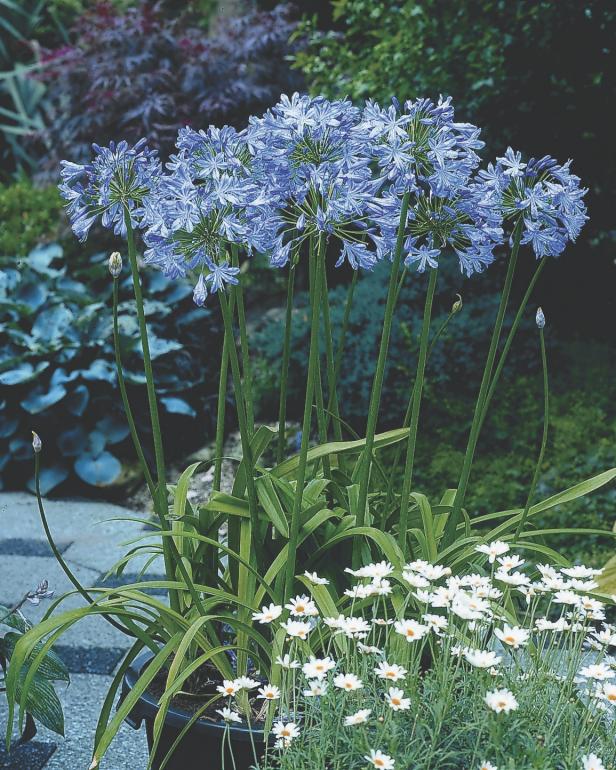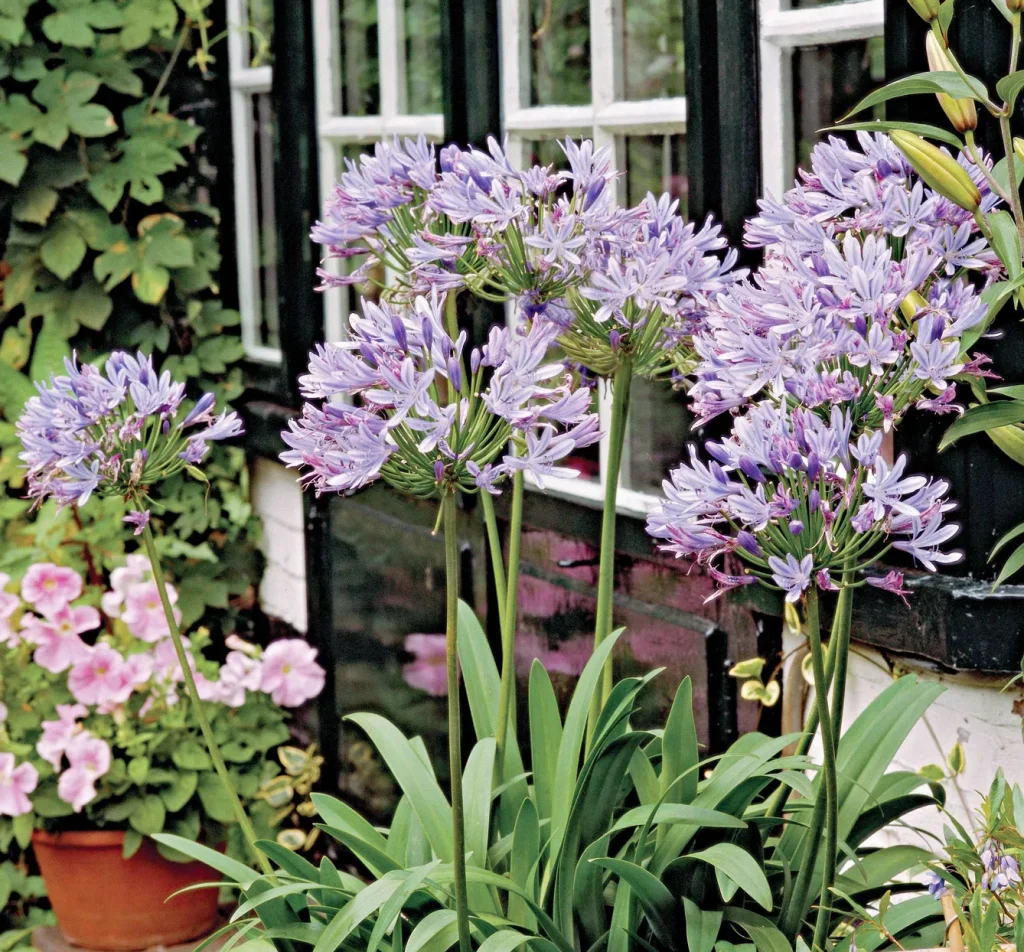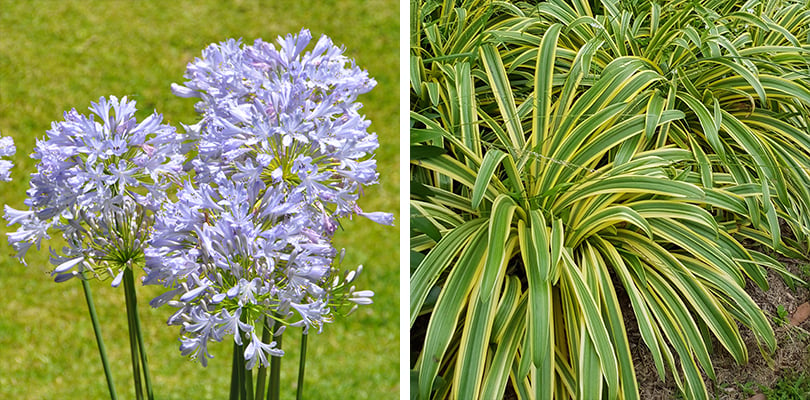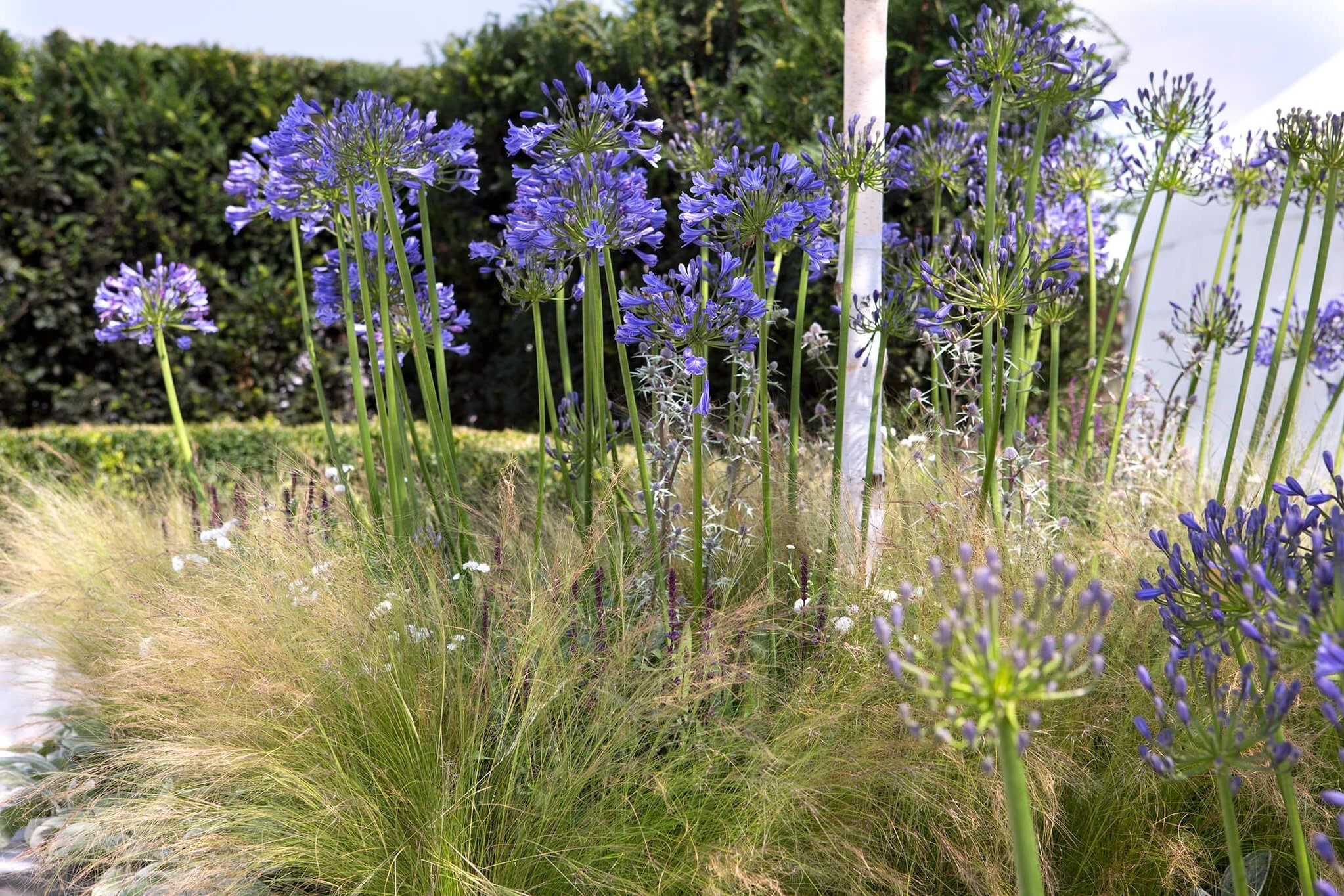Table of Contents
Add some beauty to your garden with the Agapanthus plants. These dramatic sunny plants are beautiful and very easy to grow. They are tall, strappy, and long-lasting, which makes them a great addition to any space that they are added to.
The name of this plant is derived from the Greek word agape and anthos, which means love flower.These really are love flowers because they really fill your heart with joy when you see them.
Check out how to grow & care for agapanthus here.
What is Agapanthus?
You might not recognize it by the name when we say it, but you sure will recognize it when you see it. Agapanthus, or the Lily of Nile, is a graceful, ornamental garden plant that blooms around midsummer. It lights up the whole landscape and is a beautiful addition to any garden.
Contradictory to its name, the Lily of Nile does not hail from the Nile region but is actually from Southern Africa. This plant has a globe-shaped flower cluster that grows atop all stents.
Each plant is about 18 inches wide, and the height of the plant is about 1-4 feet tall. They successfully grow in most regions, and the flowers are blue-hued and beautiful looking.
How to Grow the Lily of Nile

Maintaining and Growing Agapanthus

It is easy to grow and maintain Apaganthus by following simple steps-
- Watering: Water the plant regularly during the growing season. The first year after the planting is very crucial. Once established, these plants don’t need a lot of water, but in some summers, they might need good watering to ensure better bloom.
- Feeding: Feed your plant with a balanced fertilizer to make sure your plants grow well. If your plants are in a container, use liquid fertilizer and feel them fortnightly until the flowers start to grow. You can also put mulch around the plant when it gets too wet.
- Drainage: Make sure your soil has good drainage. If you have planted your agapanthus in a pot, make sure it has multiple drainage holes, and in the case of garden soil, make sure you cover it with mulch.
- Temperature and Humidity:Ideal temperatures for Agapanthus range from 50-60 degrees Fahrenheit. Some species can tolerate low temperatures like 20 degrees, but when the temperature is about 50 degrees, these plants should be brought indoors. Putting plants in good ventilation areas is great for cutting down the fungal problems in these plants.
When Do Agapanthus Flower?
The Agapanthus flowers bloom in mid-summer and in early spring. The exact month for Agapanthus Flowers to flower in the UK is June, July, and August. These plants, when grown with special care, flower repeatedly and for several weeks throughout the season. They are perennial plants and return every year.
Other Caring Tips for Agapanthus

1. Pruning
It is important to remove damaged leaves once a year. For agapanthus to grow well, cut back the foliage to about 4 inches in late fall after the flowers have bloomed. It is important to prune them to make sure that the plant keeps budding, and it also prevents them from becoming invasive.
2. Deadheading
Make sure you pluck dry flowers of Agapanthus when they dry out. This gives space for more flowers to bloom and keeps your plant blooming. To do this, just pluck out the dry flower, and it will be enough.
Bonus Tip: Make sure you wear a pair of gloves and use appropriate tools when pruning or deadheading the pant. Since these plants are toxic, make sure you handle them with utmost care.
How to Shop for Agapanthus
You can also keep the following things in mind when choosing to grow agapanthus.
- The height of the plant: Agapanthus ranges from being very small to being taller. That is, their height ranges from 8 inches to 1.5 feet. So, depending on where you want to plant them and how you want to plant them, choose the variety.
- Colour Is The Key: These flowers are available in various blues and whites. Take into account what color flowers you want.
- Where you want them to grow: Some varieties of Agapanthus are tough and can grow anywhere. However, there are some tender varieties too. So, where you grow are planning to grow your plant will help you decide this.
- The shape of the flower: Generally, Agapanthus are round with a trumpet shape. Some also have pendent blooms in round flower heads. You can also take this into account when choosing your plant.
It is easy to cultivate Agapanthus, and you can buy it in a local or online nursery. These plants are often sold as a bulb, but you can also buy a bare-root plant if oy want. Just ask the nursery you are buying it from for a plant that grows well in your climate. You can also research this online, and that will help you choose the variety suitable for your garden.
Planting the Agapanthus
1. Preparing The Soil
Before you get to know how to plant the Agapanthus, you will have to prepare your soil. Agapanthus is tolerant of most soil types, but it grows best in fertile, sandy loam that has great drainage. It will bloom the best if the PH of your soil is around 7. With that said, there are some species of the plant that prefer acidic soil that has a PH of 5.5 to 6.5.
2. Planting From Seed
It is very easy to plant the Agapanthus plant using seeds, but it is best to start indoors if you are planning to do it with a seed. That way, you will not feel bothered by bugs, critters, or the weather. You can start planting seeds any time around the year. You will need a seed tray with separate cells, potting mix, and a spray bottle.
- Start with filling each seed cell with potting mix.
- Spray some water and place one or two seeds flat in the mixture. You don’t have to bury or poke down the mix. Just cover this with a fine layer of soil. You can also use sand to cover this filling.
- Set the tray in a warm location but make sure it is out of direct sunlight.
- Keep moistening this but do not make it wet till the seed starts to germinate.
- It will take a few weeks in warm conditions and three months in colder areas for the seed to germinate. Do not let any chill sneak into these seed trays. The ideal temperature here is 70-80 degrees Fahrenheit.
- Once the seeds have germinated and you see three to four leaves, it is now the time to transplant it into a bigger pot. Plant them in six to eight pots with rich manure soil. You can use garden soil mixed with well-rotted compost and sand. Remember to keep the soil loose and well-drained all the time. These plants grow well in pots, and if needed, you can also plant them in wider and bigger containers later on.
3. Planting By Root Division
If you are planning to buy a bare root plant from the nursery, use the root division method of planting. A root division is a clone of the parent plant. So, if you want to replicate a plant, just divide it and plant these parts in various places around fall or springtime.
- The first step is to wear gloves when handling agapanthus since the sap from the leaves can cause skin irritation. Then start digging up the entire plant.
- Dig six-eight inches deep around the outside of the existing clump. Leave the margin of around six inches, and depending on the size of the clip, leave the margin.
- Using a knife, cut the tuberous root ball into half. Take these sections and further cut them into two parts. Now, you will have four pieces with at least one part of the shoot attached to it.
- Before you plant it, leave this division out in the warm, without sunlight. This will allow the roots to stop bleeding, and they will start healing. If you do it too soon, your plant won’t get the time to heal, and moisture will make them rot.
- Once they have started to heal, in rich, loose soil, dig a bole deep and wide enough to plant these parts in it. Set the roots inside the hole and backfill the soil and compost mixture. Cover the entire ball.
- Leave it alone and let it establish. Once it starts blooming, give it half-inch of water a week. Agapanthus is famous for surviving in a drought. So, make sure you do not overwater them.
Problems with Agapanthus
Some common problems and their solutions for Agapanthus flowers are such-
1. Pests and Plant Diseases
Agapanthus are generally highly tolerant plants and do not have many issues. However, they still attract some aphids, red spider mites, and mealy bugs. It is easy to deal with this, though. Just strongly spray with a hose, and this will knock the issues off. You can also treat these issues with horticultural spray or neem oil.
Sometimes, fungal diseases like verticillium wilt can affect overcrowded plants, and you can avoid this by giving the plants good air circulation.
2. Yellow Leaves
The leaves of Agapanthus can turn yellow around the end of the growing season. This is natural and normal in any plant. You can remove these leaves, or they shed on their own. New and green leaves will automatically grow once these are shed.
3. Reduced Blooms
Reduced blooms are an indication that your plants need to divide. Replant the new growth and get rid of older plants from the centre of the clump. This will give you better bloom.
Conclusion
Agapanthus is a flowering plant that thrives in sunny spots. They can grow almost anywhere, from moist garlands to rocky mountains.
They come in many varieties and are very attractive. They are easy to grow and give great visual elevation to your garden or home, wherever you decide to showcase them.
With minimal effort, you can grow these plants, and they will be a full bloom.
So, don’t wait up. Get started now!
Frequently Asked Questions
Where Does Agapanthus Grow Best?
Agapanthus are planted in moist and well-drained soil of clay, sand, chalk, or loam within an acidic alkaline or neutral PH balance. These plants bloom well when they are kept out in full sun. These grow well both in pots and in gardens.
What is the Best Fertilizer for Agapanthus?
You must fertilize Agapahntus twice a year to get the best blooms. A low-nitrogen, complete fertilizer that has phosphorus is best for Agapanthus.
How Long Do Agapanthus Last?
Agapanthus flowers have a relatively long flowering period that stretches from mid-summer and goes until early autumn. Depending on their variety, they can grow for longer periods.
Why is Agapanthus Dying?
Agapanthus gall midge is a fly that causes the buds of the plant to become deformed and discoloured. So, this could be a reason why your agapanthus is dying.





